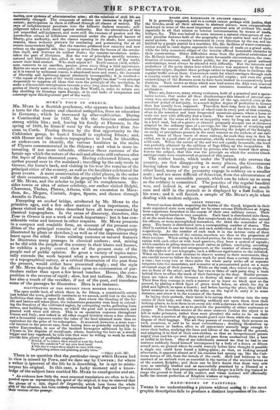HAND-ROOKS OP PAINTINGS.
THERE is no understanding a picture without seeing it : the most graphic description fails to produce a distinct impression of its clia- racteristics ; the best print only enables one to comprehend the general design, conveying but an imperfect idea of the original. This is the reason why writings on works of art are so unsatisfac- tory: exact accounts read dry and catalogue-like, and eloquent cri- ticism is tantalizing, for in proportion to the writer's vivid sense of the beauties he describes is the reader's disappointment at not being able to realize the enjoyment. To profit by critical analysis, to appreciate the worth of an opinion, or to share in the delight expressed by another, we too must see or have seen the picture or statue expatiated upon ; though in that case, perhaps, we may think that the writer falls short in speaking of some excellence that attracted us, or sets an undue value on others that did not strike our fancy. As regards the mere estimation of a great work of art, competent and impartial judges may agree ; but its influence on the mind and feeling differs in proportion to the imaginative power of the artist and the susceptibility of the beholder. This truth forced itself strongly on the attention in reading these excellent Hand-books, especially Dr. KUGLER'S of the Italian painters: whenever a work he mentions is familiar to us, it is as if a ray of light beamed in upon the twilight vagueness. Mrs. JAME- SON'S volumes, on the contrary, carry one pleasantly through the galleries as if in company with her and those fine critics Limn and IIAZLITT, whom she has associated with her : each picture she speaks of reappears to the intellectual vision, not unfrequently with fresh beauties, or seen in a new light. Dr. KUGLER'S Hand-Book is a guide to the student of the history of painting, who by its means may trace the progress of modern or Christian art through suc- cessive periods, from its first dawn in the Byzantine age down to the decline of the Italian school, of which SALVATOR Rost. and CANALETTO were the last illustrious names. Its comprehensive and orderly arrangement of the various schools, the concise enun- ciation of the characteristics of their several masters, and the distinct account of the principal works of each, supply all that is to be looked for in a compendium. KUGLER is not only an elaborate and accurate compiler, but a learned and discriminating critic ; though his judgments are not in every case to be received as sound, or un- biassed by national predilections. Mr. EASTLAKE, whose editorial labours are limited to occasional notes qualifying a sweeping judg- ment or supplying fresh or deficient information, decidedly dissents from his author on two or three prominent points; and alludes to others in which KUGLER differs from received opinions. A set of prints is wanting to complete the usefulness of this abridged history of painting : mere outlines would suffice, if executed with spirit and feeling. One plate is given—an etching of the ceiling of the Sistine Chapel—in which the outlines of the designs of MICHAEL ANGELO, minute as they are, assist in understanding the critic, if not in realizing the artist's great conceptions. It is remarkable that treatises on art are less fully and frequently illustrated than any other class of books, though they most need the introduction of engravings. The history of art should be read in its own creations : the character of the design, nay, even the expression and general effect of the picture, might be given sufficiently well in a wood- - cut, to convey, in conjunction with the text, an intelligible idea of the style of the artist. It is not till he reaches Dr. KUGLER'S fifth book, which is devoted to that culminating point in the history of painting, the sixteenth century, when LEONARDO, MICHAEL AN- GELO, RAPHAEL, Timor, and COREGGIO flourished, that the gene- ral reader will feel on sure ground. As a guide to the traveller who wishes to investigate the remains of early art in Italy this Hand-book is most valuable.
Mrs. JAMESON has well supplied the want of an instructive and explanatory account of the public galleries of pictures in and near our Metropolis : the information given is full, and conveyed in a popular form ; and those who visit the National Gallery, Hampton Court, Windsor, and Dulwich, with her Hand-book for their guide, will derive from its pages much pleasure and knowledge. Its plan is this : a separate account is given of the history of each col- lection; which is followed by a catalogue raisonne, enumerating every picture, stating the name of the painter, describing the
• nature of the subject, giving some particulars of the artist or his work, quoting the best critical opinions of its merit, and mention- ing by whom it has been engraved : and a clear explanation of the meaning of terms used in the artist's vocabulary, together with some detached thoughts on painting, culled from the best writers, are given in an introduction. Mrs. Jsmasos has evidently taken great pains in bringing together a variety of opinions ; thus making the critical portion eclectic, and merging her individual preferences in the general view. , Mrs. JAMESON'S Hand-book requires no other illustrations than the pictures themselves which she describes; it being intended for reference in the galleries. The value derivable from her labours consists in the interest which visiters will take in the picture be- fore them, from knowing all that can be told about it; and the desire that will be thus induced to extend their acquaintance with works of art. An intelligent catalogue to a public gallery is as glasses to the dim-sighted; and we shall be glad to see these spectacles in frequent use.



























 Previous page
Previous page